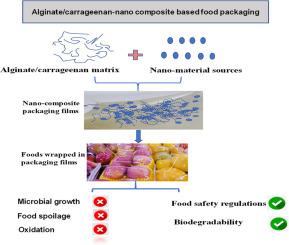Bioactive alginate and carrageenan nanocomposite packaging: a review of recent insights on fabrication techniques, applications and environmental concerns
IF 6.5
Q1 CHEMISTRY, APPLIED
Carbohydrate Polymer Technologies and Applications
Pub Date : 2025-09-18
DOI:10.1016/j.carpta.2025.101011
引用次数: 0
Abstract
Polysaccharide-based bioactive films from alginate and carrageenan are gaining interest in food packaging, biomedical applications, and environmental sustainability. From the past decade, film/coating improvements have been talking of the town through different research modifications. Approaches such as modifying the polymer matrix along with the addition of different plants and animal-based additives have been explored in the area concerned to enhance film performance. Developing films by the addition of nanocomposites based on alginate and carrageenan presents a unique and robust method towards enhancing the functional and techno-functional characteristics of packaging film/coatings credited to the synergistic combination of natural polymer matrices and incorporated nanomaterials. There are some studies discussing the usage of these polymers in the packaging industry. However, our study adds on the approach by discussing the development of films/coatings using the alginate and carrageenan blend. This review paper delves into the recent advancements and applications of polysaccharide-based bioactive films, focusing specifically on alginate and carrageenan. It covers the diverse applications of these polymers in the development of nanocomposites for antimicrobial packaging. This study systematically examines antimicrobial agents derived from fruit byproducts, animal sources, and probiotic agents, and their integration into packaging materials. The paper examines the characteristics of antimicrobial packaging systems, focusing on their barrier and mechanical properties. Various techniques for the development and fabrication of these films are discussed, highlighting the role of different polysaccharides in film formation. The properties of the developed films are analyzed, particularly their antimicrobial mechanisms of action against bacteria, fungi, and viruses. The possible uses of these bioactive films in food packaging are described, particularly for fruits and vegetables, meat and meat products, and dairy products. This study highlights the significant potential of alginate and carrageenan-based bioactive films, along with the blends thereof enhanced with nano-sized particles, to boost food safety, food quality and extend the shelf life of perishable products. Lastly the manuscript also focuses on safety regulations towards the food packaging films/coatings developed from these polymers for their wider applications.

生物活性海藻酸盐和卡拉胶纳米复合包装:最近的制造技术,应用和环境问题的回顾
海藻酸盐和角叉菜胶制备的多糖类生物活性薄膜在食品包装、生物医学应用和环境可持续性方面越来越受到关注。从过去的十年中,通过不同的研究修改,薄膜/涂层的改进一直是人们谈论的话题。在有关领域,人们已经探索了诸如改性聚合物基体以及添加不同植物和动物基添加剂等方法来提高薄膜性能。通过添加基于海藻酸盐和卡拉胶的纳米复合材料来开发薄膜,是一种独特而稳健的方法,可以增强包装薄膜/涂层的功能和技术功能特性,这归功于天然聚合物基质和掺入纳米材料的协同结合。有一些研究讨论了这些聚合物在包装工业中的使用。然而,我们的研究通过讨论使用海藻酸盐和卡拉胶共混物的薄膜/涂层的发展,增加了这种方法。本文综述了多糖基生物活性膜的研究进展及其应用,重点介绍了海藻酸盐和卡拉胶。它涵盖了这些聚合物在抗菌包装纳米复合材料开发中的各种应用。本研究系统地考察了从水果副产品、动物来源和益生菌制剂中提取的抗菌剂及其与包装材料的整合。本文考察了抗菌包装系统的特点,重点介绍了它们的阻隔性和机械性能。讨论了开发和制备这些薄膜的各种技术,重点介绍了不同多糖在薄膜形成中的作用。分析了显影膜的性能,特别是对细菌、真菌和病毒的抗菌作用机制。描述了这些生物活性薄膜在食品包装中的可能用途,特别是用于水果和蔬菜,肉类和肉制品以及乳制品。这项研究强调了海藻酸盐和卡拉胶基生物活性薄膜的巨大潜力,以及纳米颗粒增强的混合膜,在提高食品安全、食品质量和延长易腐产品的保质期方面的巨大潜力。最后,手稿还侧重于安全法规对食品包装薄膜/涂料开发从这些聚合物为其更广泛的应用。
本文章由计算机程序翻译,如有差异,请以英文原文为准。
求助全文
约1分钟内获得全文
求助全文

 求助内容:
求助内容: 应助结果提醒方式:
应助结果提醒方式:


